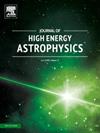Insights into the long-term behavior of the optical polarization from the blazar 1ES 1959+650
IF 10.5
4区 物理与天体物理
Q1 ASTRONOMY & ASTROPHYSICS
引用次数: 0
Abstract
A high degree of linear polarization measured in the optical emission is an important observational feature of blazars. It provides strong evidence of the presence of relativistic particles and magnetic field ordering in the non-thermal emission regions of blazars owing to the synchrotron nature of low energy radiation. Thus, the polarization studies of blazars are emerging as a promising approach to probe the particle acceleration and the physical processes involved in their broadband emission. In this work, we investigate the behavior of the optical polarization of the blazar 1ES 1959+650 measured over a decade using the spectropolarimetry (SPOL) at the Steward Observatory. We use measurements of the degree of linear polarization and angle of polarization in the wavelength range 500 - 700 nm available during the period October 1, 2008 and June 30, 2018 (MJD 54739 - 58299) from the SPOL observations. Near simultaneous photometry data in the R and V bands are also used to study the optical emission from the source. The maximum degree of linear polarization, measured as ∼ 8.5%, is significantly larger than the long term average value of ∼ 4.6%. Analysis of the light curves indicates that the optical emission from the blazar 1ES 1959+650 is highly variable and variability in the degree of linear polarization can be quantified by a fractional variability amplitude of ∼ 39% over the period of about ten years. Long term optical emission in the R and V bands is very weakly anti-correlated with the degree of linear polarization. Modeling of the polarization due to the synchrotron emission suggests that the observed degree of linear polarization can be broadly reproduced by a power law distribution of relativistic electrons gyrating in a spherical emission region permeated with chaotic and ordered magnetic fields. Variation in the measured degree of polarization may be attributed to the interplay between the two magnetic field components in the emission region. The effect of stellar emission from the host galaxy of the blazar 1ES 1959+650 on the degree of synchrotron polarization originating from the jet is also discussed.
从耀变体1ES 1959+650观察光偏振的长期行为
在光发射中测量到的高度线偏振是耀变体的一个重要观测特征。由于低能辐射的同步辐射性质,它提供了在blazars的非热辐射区域存在相对论性粒子和磁场有序的有力证据。因此,对耀变体的偏振研究是一种很有前途的方法,可以用来探测粒子加速及其宽带发射的物理过程。在这项工作中,我们研究了在Steward天文台使用分光偏振仪(SPOL)测量的耀变体1ES 1959+650的光学偏振行为。我们使用了2008年10月1日至2018年6月30日期间(MJD 54739 - 58299) SPOL观测中500 - 700 nm波长范围内的线偏振度和偏振角测量值。R和V波段的近同时光度测量数据也被用于研究光源的光发射。测量到的最大线极化度为~ 8.5%,明显大于长期平均值~ 4.6%。对光曲线的分析表明,耀变体1ES 1959+650的光发射是高度可变的,线偏振度的变异性可以通过在大约10年的时间内约39%的分数变异性幅度来量化。R和V波段的长期光发射与线偏振度的反相关非常弱。由同步辐射引起的极化模型表明,观测到的线性极化程度可以广泛地由相对论电子在充满混沌和有序磁场的球形发射区内旋转的幂律分布再现。测量到的极化度的变化可归因于发射区两个磁场分量之间的相互作用。本文还讨论了blazar 1ES 1959+650宿主星系的恒星辐射对喷流产生的同步加速器偏振度的影响。
本文章由计算机程序翻译,如有差异,请以英文原文为准。
求助全文
约1分钟内获得全文
求助全文
来源期刊

Journal of High Energy Astrophysics
Earth and Planetary Sciences-Space and Planetary Science
CiteScore
9.70
自引率
5.30%
发文量
38
审稿时长
65 days
期刊介绍:
The journal welcomes manuscripts on theoretical models, simulations, and observations of highly energetic astrophysical objects both in our Galaxy and beyond. Among those, black holes at all scales, neutron stars, pulsars and their nebula, binaries, novae and supernovae, their remnants, active galaxies, and clusters are just a few examples. The journal will consider research across the whole electromagnetic spectrum, as well as research using various messengers, such as gravitational waves or neutrinos. Effects of high-energy phenomena on cosmology and star-formation, results from dedicated surveys expanding the knowledge of extreme environments, and astrophysical implications of dark matter are also welcomed topics.
 求助内容:
求助内容: 应助结果提醒方式:
应助结果提醒方式:


